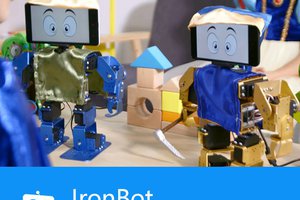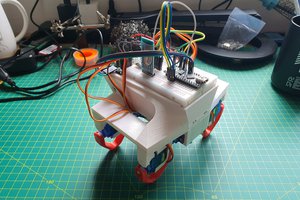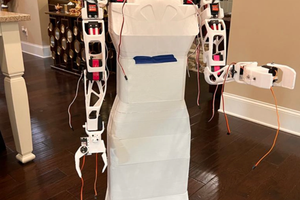Two Leg Robot
This Robot, I affectionately call "Helper 1.0", uses the rack and pinion linear actuators from the ScienceRobot Robot Kit and assocaited Robot App. The linear actuators allow for human-like joints, since motors are not located at the joint (for example at the knee), but are instead located on the center of each body part. For example, I use a ball and cup joint for the leg-hip joint, very similar to a human hip ball-joint. The linear actuators also provide a tremendous amount of holding strength, even with small gear motors- this was a surprising secret to uncover. As evidence of this great holding power, this robot can easily be balanced to stand on one foot and can stand that way for hours. Currently, this robot is only a lower body (and torso), but I plan to add an upper body once I have ironed out basic walking. As I write this, I have not had enough time to get this robot to walk, but have had it take both a forward and side step- although it does not usually stay standing after the step. So currently the robot can lean left, center, and right. It does this by estimating the angle each of its joints are at from accelerometer and gyroscope sensors which are sampled in real-time 100 times a second at 10ms intervals. The process of development on this robot usually takes the form of adding instructions to a script, running the script, and then using the Robot app to run through the script using the accelerometer/gyroscope data to replay the motion on a 3D model of the robot in slow motion. It is really cool to see how within milliseconds, a motor thrusts, and fixes its associated body part- for example, the code detects that the torso is falling forward, and then the torso motor counters that motion and you can see the angle change from red to orange as the app recognizes that the body segment has stopped moving away from the target angle, and is now moving toward the target angle- then finally the angle turns green to indicate that the body segment is within the target angle range. So of course, much more work needs to be done on this robot, but the basic idea of using very low cost linear actuators, that use $8 gear motors with a $2 clamping coupling seems to me to be a very valuable and interesting design. I have to admit that the robot looks more like a "mech" than a humanoid robot, but this design, for the cost and strength, seems in my mind to be the most promising from my perspective of building robot over the last 10+ years.
Future Enhancements
*head, arms, and hands - using the same linear actuator design in order to keep the weight of the robot down to a minimum
*plastic gear motor cases - to reduce weight more
*hip motors - to allow the legs to be turned in the yaw direction (around the Y axis).
*low cost gantry - to hang the two-leg robot from when having the robot stand is not possible.
Hackaday Prize Information
1. The challenge the project addresses: How can a low cost, totally open-source hardware and software two-leg (humanoid) robot be achieved?
2. How this project will alleviate or solve the problem of achieving a low cost, open-source two-leg robot: while this design is far from being a complete dish or laundry washing low-cost robot, it is close to being able to walk, is very inexpensive, and in my mind has great potential to become a very valuable human assistant.
3. I think this Two-Legged Robot has the potential to be world changing because like life on earth before the first motorized airplane, or telephone- we humans often have trouble recognizing what is in store in our near future and how very different our world will look. The development of low-cost very smart and helpful robot assistants seems inevitable and will definitely change life on earth. Humans will probably never have to wash their dishes or clothing, mow their lawns, or even have to do any manual labor within the next century. So here we are now, with this very crude low cost two-leg robot design, and the space...
Read more » Ted Huntington
Ted Huntington




 tab
tab
 Nguyễn Phương Duy
Nguyễn Phương Duy
 Pascal Buerger
Pascal Buerger
Hello, very interesting, can you tell me examples bits for actuators/Motors/accels, cause I can't find any "Bom" files (.zip)?